Jellyfish move their umbrella-shaped bodies through the water with a bizarre sense of propulsion. Certain jellyfish, in particular, are among the planet’s most venomous creatures. They can be harmful.
Jellyfish come in a variety of sizes, from little coastal species to enormous deep sea creatures the size of blue whales! There is a lot to learn about jellyfish, given their diverse nature. We’ve gathered information on jellyfish, including distinct species and essential facts, from the internet’s greatest source.
The 15 Must-Know Types of Jellyfish

1. Lion’s Mane Jellyfish (Cyanea capillata)

With some specimens approaching the size of a blue whale, the lion’s mane jellyfish is the world’s biggest species of jellyfish. The bell of the largest recorded lion’s mane jellyfish was seven feet (2.13 meters) in diameter and had 112 foot (34.13 meters) of tentacles. The mane of these creatures is covered in roughly 1,200 tentacles.
In the Arctic and North Pacific Oceans, lion’s mane jellyfish are most often found floating in the open water. The tentacles of lion’s mane jellyfish are bioluminescent and contain millions of painful stinging cells, from which the lion’s mane jellyfish produces venom. Lion’s mane jellyfish, on the other hand, are mostly found in frigid water and thus rarely come into contact with humans.
2. Upside-Down Jellyfish (Cassiopea sp.)

In comparison to most jellyfish, upside-down jellyfish behave differently. They sit with their bell on the ground, extending their tentacles up to catch food, instead of floating bell-up through the ocean. In tropical seas around the world, upside-down jellyfish are most often seen in sheltered coastal areas.
The defense and hunting mechanism of Upside-down jellyfish is unique. To catch prey and protect themselves from predators, these jellyfish release mucus laden with nematocysts into the water. However, the venom of a single upside-down jellyfish isn’t particularly powerful, and when one jellyfish spreads envenomated mucus throughout the colony, the whole colony follows suit.
A small stinging sensation in the water has been reported by people swimming in these seas, which is most likely due to the upside-down jellyfish’s mucus.
3. Moon Jellyfish (Aurelia aurita)

In coastal waters around the world, except in the Arctic Ocean, moon jellyfish are one of the most common jellyfish. The reproductive tissues of the bells have a distinctive half circle shape. They’re safe to touch because their sting isn’t powerful enough to penetrate human skin, making them an common aquarium species.
When handled in the dark, moon jellyfish emit a bright purple light. One of the most common species consumed by humans is moon jellyfish.
4. Nomura Jellyfish (Nemopilema nomurai)
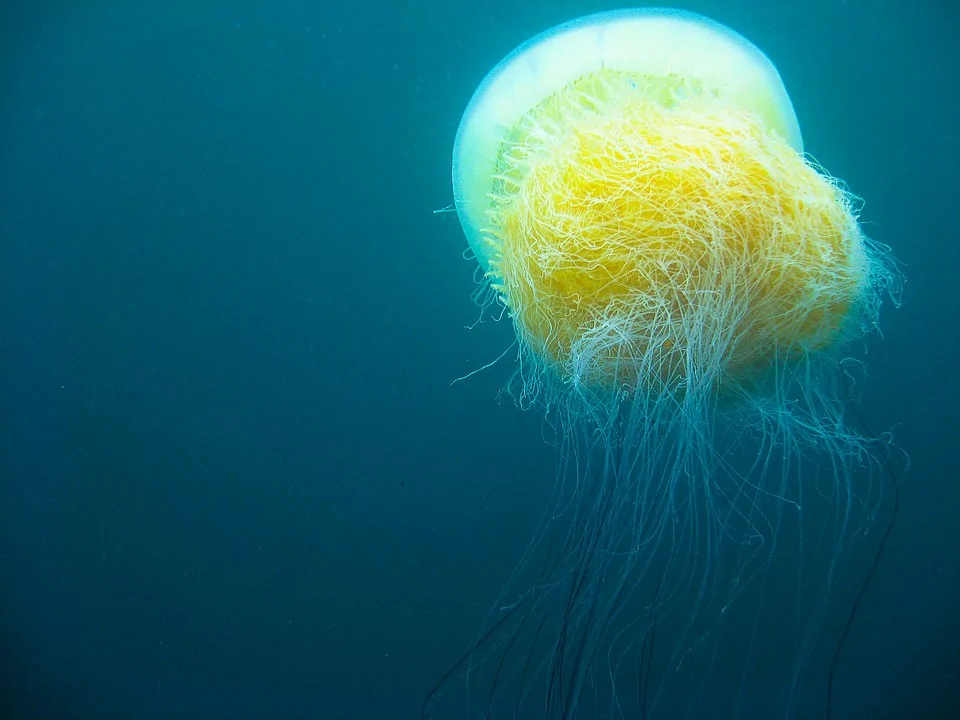
The Nomura jellyfish, one of the biggest jellyfish species, may reach a diameter of up to six feet (1.82 m) and weigh over 400 pounds (181.43 kg). Between China and Japan, Nomura jellyfish flourish in the seas, causing massive jellyfish blooms that kill fish populations.
Special research teams have been established to investigate why Nomura jellyfish grow so big and how the population may be lowered to a safer level, which has become such a serious issue for China and Japan.
A combination of hydroelectric projects and farming along the Yangtze River, which has created enriched nutrient habitats in the Sea of Japan, these scientists believe Nomura jellyfish are able to grow so large.
Nomura jellyfish have a unique defense mechanism, even though it should be simple to remove jellyfish blooms from the water. They release billions of sperm and eggs, which attach to the ocean floor and turn into more jellyfish, when they sense danger.
5. Deep Red Jellyfish (Crossota norvegica)

Because their habitat is difficult to explore, little is known about the deep red jellyfish. The deep red jellyfish may be found 3,000 feet (914.4 meters) or more below the surface of the Arctic Sea’s water. These jellyfish are just two centimeters (0.78 inches) in diameter, making them one of the smallest species available.
It’s unclear whether deep red jellyfish reproduce sexually or asexually, since they don’t go through a polyp phase. The deep red jellyfish has been labeled as alien-like by scientists due to its numerous peculiar features.
6. Four-Handed Box Jellyfish (Chiropsalmus quadrumanus)

The West Atlantic Ocean, Gulf of Mexico, and Pacific Ocean all have four-handed box jellyfish. A bell about the size of a fist with tentacles up to 13 feet long (3.96 m) makes this jellyfish transparent.
The venomous sting of the four-handed box jellyfish, which can be deadly to small children, has been documented to kill humans within minutes of being stung.
7. Sea Wasp Jellyfish (Chironex fleckerii)

In Australia and Southeast Asia, the sea wasp jellyfish may be found in coastal waters. With a bell measuring approximately eight inches (20.32 cm) and tentacles up to ten feet long (3.04 m), this is the world’s largest cubozoan jellyfish.
The sea wasp is the most venomous jellyfish, and it has the quickest and strongest response of any venomous creature. The tentacles’ contact with the prey causes severe discomfort that is followed by heart failure, resulting in death within a few minutes. Sea wasps are a common food source for leatherback turtles and other large sea creatures because this venom is best suited for capturing prey and isn’t useful to deter predators.
Scientists have discovered a unique part of the venom that drills holes in the victim’s red blood cells and are studying why the sea wasp jellyfish’s venom is so potent. Researchers are getting closer to developing an antiacetylcholinesterase against the venom of the sea wasp jellyfish.
8. Immortal Jellyfish (Turritopsis dohrnii)

With a crimson stomach apparent in the center of its transparent bell, the immortal jellyfish is smaller than a pinky nail. In temperate to tropical seas all around the globe, this jellyfish may be found.
Because of their particular life cycle, this species of jellyfish is known to be immortal, as the common name implies. The Turritopsis dohrnii settles on the seafloor and turns into polyps, which spawn new jellyfish clones instead of completing the life cycle and dying after the medusae phase.
This oddity in the life cycle isn’t just utilized as a defense mechanism at the natural conclusion of their lives; it’s also employed there. This jellyfish reverts back to a polyp when it is threatened by predators or runs out of food, and starts anew. Transdifferentiation is the term for this cellular process, and scientists are exploring its possibilities in the medical field.
9. Mangrove Box Jellyfish (Tripedalia cystophora)

In Central America’s coastal mangrove forests, the mangrove box jellyfish may be found on the seafloor. They have a bell the size of a grape and tentacles that are roughly an inch long, making them look rather tiny.
Their venom is not harmful to people, despite being closely related to the sea wasp and other highly venomous box jellyfish. Mangrove woodlands are one of the most endangered ecosystems on the planet, and box jellyfish are losing their habitat.
The mangrove box jellyfish has no suitable habitat since these mangrove forests are cleared for development, agriculture, and fish farming.
10. Crystal Jellyfish (Aequorea victoria)

From the Bering Sea to Southern California, crystal jellyfish may be found in the Pacific Ocean. With lengthy, thin tentacles, these nearly transparent jellyfish may grow up to 10 inches (25.4 cm) in diameter.
Bioluminescence and a green-blue tint when agitated distinguish crystal jellyfish from others. Researchers studying genes have used the bioluminescent cells from crystal jellyfish as genetic markers.
By opening their specialized mouth, crystal jellyfish may consume prey up to half their body size. Larger animals, such as ocean sunfish, may be attracted to them as a common prey species. The species that consume plastic bags and other waste floating in the sea mistake them for crystal jellyfish, causing problems.
11. Black Sea Nettle (Chrysaora achlyos)
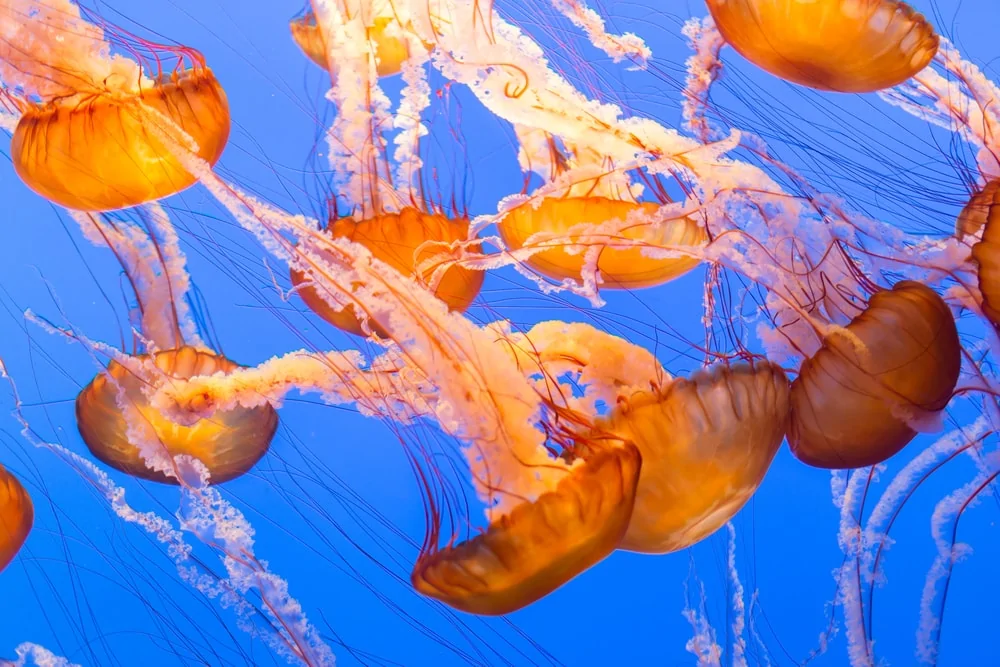
The bells of the black sea nettle, which can reach three feet (0.91 m) in diameter and have tentacles that stretch twenty-five feet (7.62 m), is one of the enormous jellyfish species. Because they dwell in deep water and are difficult to raise in captivity, little is known about the black sea nettle.
They are typically found off the southern coast of California and down the Pacific Coast of Mexico, where they have been known to form dangerous blooms in San Diego Bay.
Pacific butterfish feeds on the plankton gathered by the black sea nettle, and when danger is near, it hides inside the jellyfish’s bell, which provides both food and protection.
12. Fried Egg Jellyfish (Cotylorhiza tuberculata)
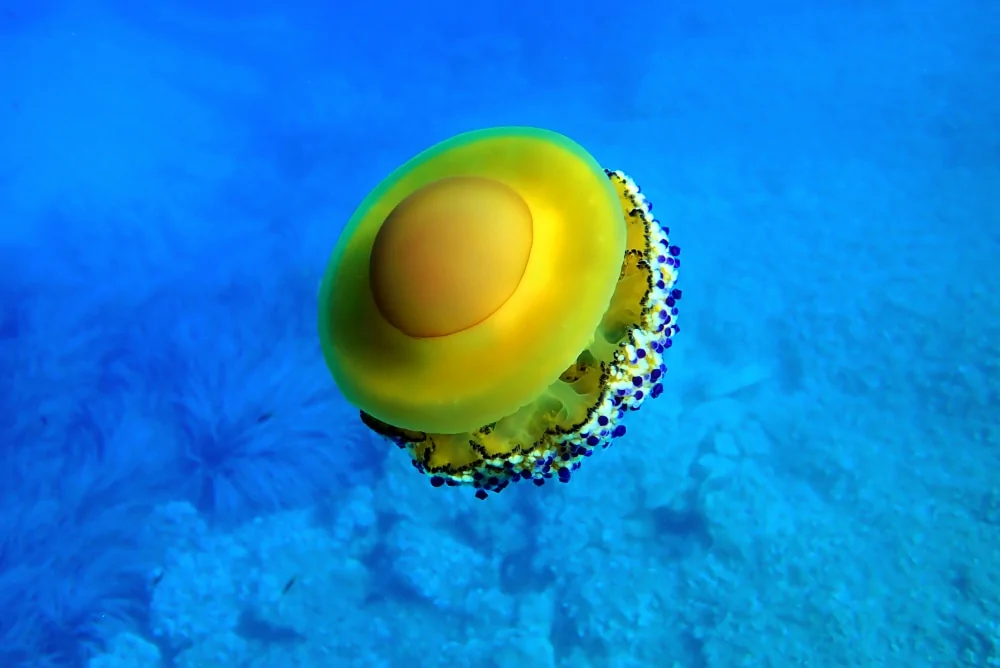
The distinctive yellow circle on the center of the fried egg jellyfish’s bell gives it its name. They are sometimes referred to as Mediterranean jellyfish, and they exist only during the summer and die when the water gets colder.
They grow to around sixteen inches (40.64 cm) in diameter and are mostly found in the Mediterranean, Adriatic, and Aegean Seas. They have a tiny sting that is seldom painful to humans, and they have been documented to carry little creatures like crabs on top of and inside their bell.
13. Atolla Jellyfish (Atolla wyvillei)
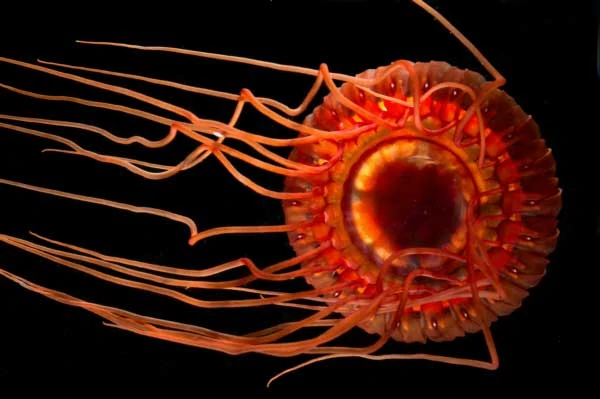
The deepest regions of the ocean, all around the globe, are home to atolla jellyfish. Atolla jellyfish live in the midnight zone of the ocean and use bioluminescence to ward off predators rather than attract prey, growing between 3,280-13,000 feet (999.74 – 3,962.4 m) below the surface.
The atolla jellyfish’s natural red coloration serves as camouflage in the deep sea, with a bell diameter of around six inches (15.24 cm). Bioluminescence is used by them to startle predators when they are under attack.
14. Cauliflower Jellyfish (Cephea cephea)
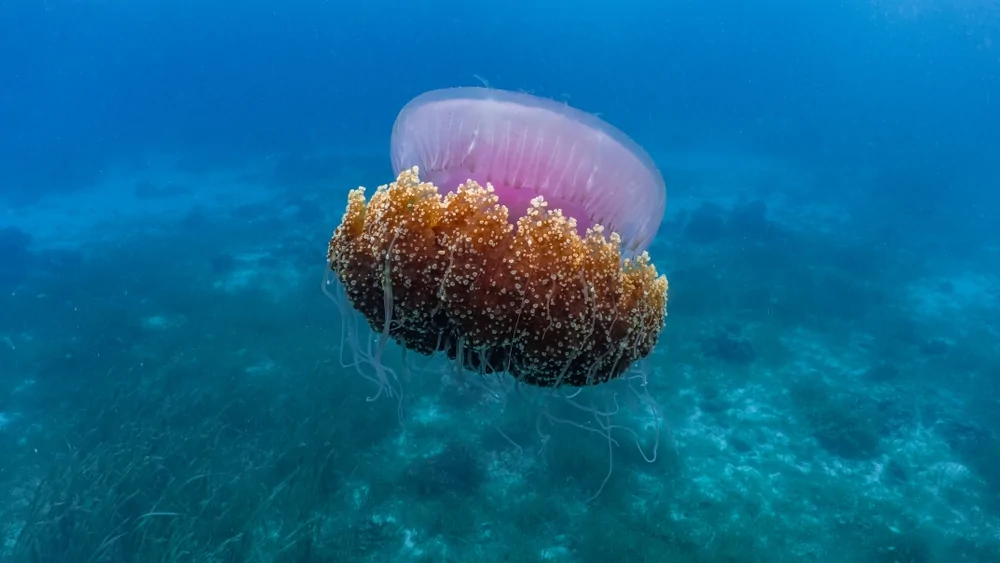
The bell of a cauliflower jellyfish or crown jellyfish is roughly seven inches (17.78 cm) in diameter and may be found in subtropical oceans worldwide. These jellyfish are one of the most poisonous, but their venom has no effect on humans.
During the day, these jellyfish are found deep in the sea, and at night they come closer to the surface. When they’re threatened by predators, they emit Bioluminescence and glow. People in Japan and China eat cauli jellyfish on a regular basis, and they have even been utilized for medical reasons.
15. White-Spotted Jellyfish (Phyllorhiza punctata)
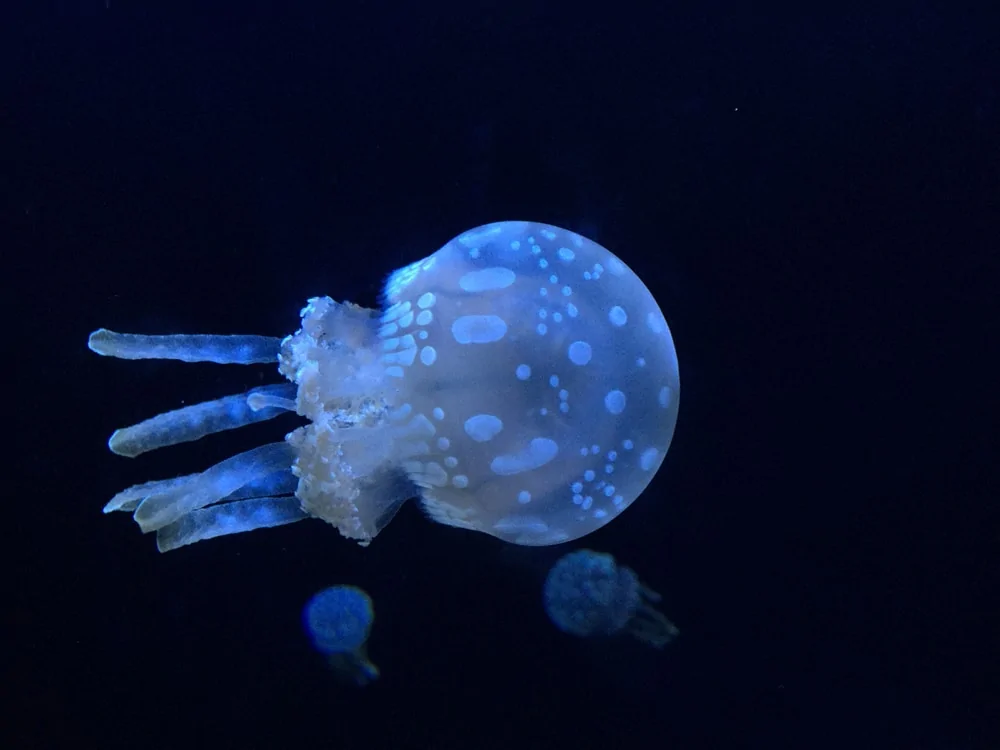
In the western Pacific Ocean, white-spotted jellyfish may be found in tropical waters. The white dots on their bell and tentacles earned them the name. White-spotted jellyfish don’t use venom to capture their prey, and they don’t pose a danger to humans. These jellyfish, on the other hand, are filter feeders that consume small zooplankton.
White-spotted jellyfish usually create blooms that sweep away all of the plankton in a local pond, wreaking havoc on the ecosystem. In regions without any marine snails, these jellyfish become invasive species, the most common white-spotted jellyfish predator.
Interesting Facts About Jellyfish

- glow in the dark is seen in around half of all jellyfish species. To avoid predators, these jellyfish use bioluminescence. Some species radiate chains of light or release glowing particles into the water to confound predators, while others utilize Bioluminescent flashes to startle them. The majority of bioluminescent jellyfish may be found at depth, although a few kinds, such as the moon jellyfish, are found at shallower depths and may be seen by humans in the wild
- A smack is a collection of jellyfish, whereas a bloom is a collection of smacks.
- Jellyfish have certain key internal organs that are lacking in various other invertebrates. Brains, hearts, and eyes aren’t found in jellyfish. They have a simplified digestive system, just a mouth and a stomach.
- Jellyfish are supposed to have stalked dinosaurs. A well-preserved jellyfish fossil was discovered in Utah in 2007 and believed to be over 505 million years old. The first jellyfish lived before the dinosaurs, at a age of about 230 million years. Jellyfish are also the planet’s oldest multicellular organism, according to this research.
- In space, there have been over 60,000 jellyfish. To see how jellyfish responds to a lack of gravity, an experiment was done in 1991. To find out, scientists flew over 2,000 polyps into space. Around 60,000 medusa jellyfish were produced by those polyps. Jellyfish in orbit looked to be working OK without gravity, but when brought back to Earth, they didn’t.
- Jellyfish have 5% protein, 95% water, and 95% nerve cells. The human body contains roughly 60% water, for context.
The Complete Jellyfish Guide: Lifespan, Diet, Predators, Sting & Myths
Physical Description and Jellyfish Lifespan

Jellyfish have no bones or even cartilage in their bodies, so they are all invertebrates. Jellyfish with umbrella-shaped bells may squeeze their bells to swim faster through the water. Stinging cells known as nematocysts may cover their tentacles. Prey is captured and predators are repelled by these cells.
The majority of jellyfish only survive for a year, while some of the lesser-sized varieties barely survive a few days.
Jellyfish Classification
Corals and anemones are both members of the phylum Cnidaria, which includes jellyfish. The specialized stinging cells of all cnidarians are used to protect themselves from predators and seize prey.
The medusa phase, which is also the reproductive phase, is generally referred to as jellyfish in a cniderian’s life cycle. Fertilized eggs, called planula, develop into larvae that constitute the cniderian life cycle. Polyps grow from planulas that attach to the ocean floor.
Many little medusas may develop from each polyp, eventually becoming reproductive adult medusas. Babies jellyfish aren’t really jellyfish since only mature medusas are real Jellyfish!
The Medusozoa subphylum includes jellyfish as well. Jellyfish branch off from other Cnidaria and are divided into four classes at this point.
Classification of Jellyfish Species
Scyphozoa, cubozoa, hydrozoa, and staurozoa are the four types of jellyfish.

Scyphozoa, or true jellyfish, are a species of jellyfish that can be found in every ocean on the planet. Most scyphozoa live in coastal seas, but some are deep-sea jellyfish. Since they go through both a polyp and medusa stage, Scyphozoa are recognized as genuine jellyfish.

There are only 20 species of box jellyfish in the class cubozoa. The bell of a Cubozoa is cube-shaped rather than round, which distinguishes it from other jellyfish. Most species of box jellyfish can produce extremely powerful venom and are found in tropical and subtropical seas.
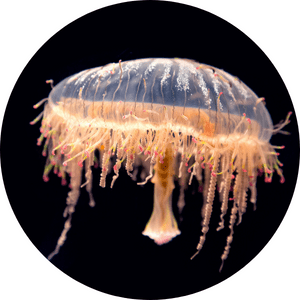
More than just jellyfish belong to the class hydrozoa. The cnidarian class Hydrozoa has a wide range of species. The medusa stage isn’t found in all hydrozoa species, thus jellyfish aren’t found in all hydrozoans.
Around 1000–1500 species of hydrozoa exist, among which are several that stay in the polyp stage and can’t be called jellyfish. Hydrozoans are the most numerous in warm, shallow seas and may be found in all oceans.
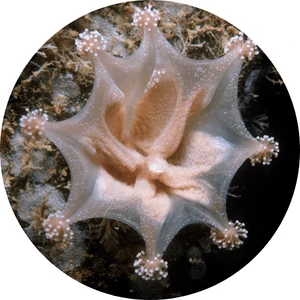
Unlike the other three jellyfish classes, the class staurozoa is unique. Staurozoa spend their whole lives attached to rocks or algae rather than swimming freely during the medusa stage, and are also known as stalked jellyfish. The staurozoa are a jellyfish species that can only be found in cold water along the coast. There are around 50 different types of staurozoa.
Jellyfish Habitat and Range
Saltwater, brackish, or slightly salty water may be home to jellyfish. The majority of jellyfish live in the coastal zone, although some live in the pelagic zone of the open ocean’s deep sea or near the surface. Every ocean on Earth has jellyfish.
Near Shore and Deep Sea Jellyfish Species
Jellyfish may be found in every corner of the ocean and around the globe. In coastal zones, smaller, transparent jellyfish are common. Red coloration allows certain deep-sea creatures to blend in with the environment.
Jellyfish may be bioluminescent, giving them the ability to attract prey or scare predators by producing their own light. They can be found both on the shore and in the deep sea.
Jellyfish Diet & How They Catch Their Food
Carnivores make up all jellyfish. Little plants, copepods, fish eggs, tiny fish larvae, and the larvae of other marine creatures are the preferred foods of most jellyfish. Lobsters, shrimps, barnacles, crabs, and other things are caught up in the tentacles of bigger jellyfish. Certain jellyfish, in fact, devour other jellyfish!
Jellyfish tentacles trap food, which they then eat. The tentacles will poison the food, which the jellyfish will capture and carry into its mouth using its oral arms. Little Jellyfish will consume whatever is available in the water around them, but they do not actively seek prey. Some jellyfish have a poisonous sting that can be fired out to capture potential prey, while others actively capture and kill their food.
Jellyfish Natural predators
Jellyfish are eaten by a variety of bigger carnivorous marine creatures. Jellyfish is eaten by many species of spadefish, sunfish, and sea turtles. Smaller jellyfish are eaten by bigger jellyfish. Coastal jellyfish are frequently consumed by birds. Jellyfish may be eaten as a delicacy in some civilizations! Jellyfish predators exist as well.
Climate Change Impact

Because their prey populations are dwindling, some jellyfish populations are growing as ocean temperatures rise. Jellyfish blooms are becoming more frequent, and fisheries and powerplants that use seawater for cooling are being disrupted. Inhabited water may also pose a threat to people who are swimming in jellyfish blooms.
Jellyfish and Human Interactions
Although all jellyfish sting, not all of them have venom powerful enough to harm people. Swimming with jellyfish is a popular tourist activity in some regions of the globe, and several species pose no danger to humans.
The stinging cells on jellyfish tentacles help them capture prey and protect themselves. Nematocysts are cell types that release a stinging barb covered in venom to cause a chemical reaction with their prey.
The toxins secreted by jellyfish nematocysts harm their prey in a variety of ways and impede their behavior. Each year, there are more than 150 million jellyfish stings around the world.
Depending on the type of jellyfish, the symptoms will be different if you get stung by one. Minor stings cause mild discomfort and itching, with a possible rash. Difficulty breathing, muscle cramps, chest discomfort, numbness, skin blistering, nausea, and even problems swallowing may occur as a result of more severe stings.
The crucial first step in removing any nematocysts that are still on the skin is to rinse the injured region with seawater. Any tentacles that are still on the skin should be removed using tweezers. To reduce swelling, apply an ice pack.
Applying freshwater or vinegar to certain species causes more nematocysts to be released, which makes the sting worse. To reduce the stinging feeling, vinegar may be used, however it should only be utilized after all nematocysts have been eliminated and the region has been thoroughly cleaned.
Most jellyfish stinger ointments and therapies are unnecessary, but you only need to remove the stingers and nematocysts and let the injury alone to recover.
Jellyfish Myths

1. Urine will relieve jellyfish sting.
Urine will relieve a jellyfish sting, according to perhaps the most widespread jellyfish myth. Urine is acidic enough to neutralize the nematocysts and eliminate the stinging feeling, according to the theory. Unless the urine came from a person who was severely dehydrated, this isn’t true.
Cleaning the stung area with seawater is your best option to alleviate pain from jellyfish stings. The sting can be eased with vinegar, but it is usually cleaned first.
2. Jellyfish attack humans.
The notion that jellyfish assault humans is another common jellyfish misconception. Jellyfish have little ability to choose which way they float, therefore this is also untrue. If you were in the same location as a jellyfish, it wouldn’t be trying to consume you, so you’re secure from jellyfish attacks. It wasn’t an intentional attack! Even if you’re in the same water as a jellyfish, you may get stung.
